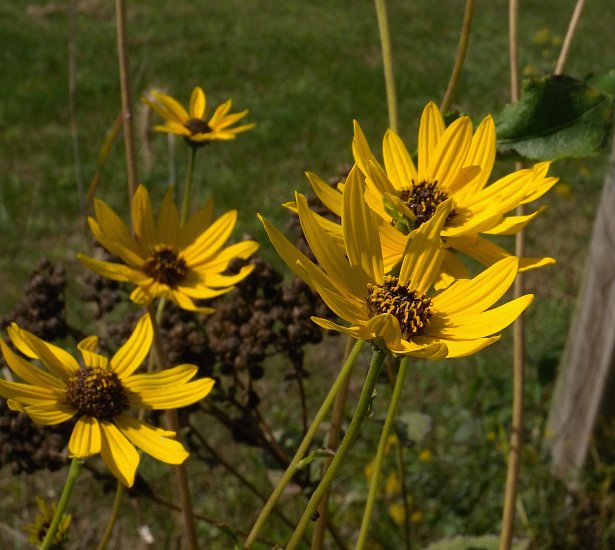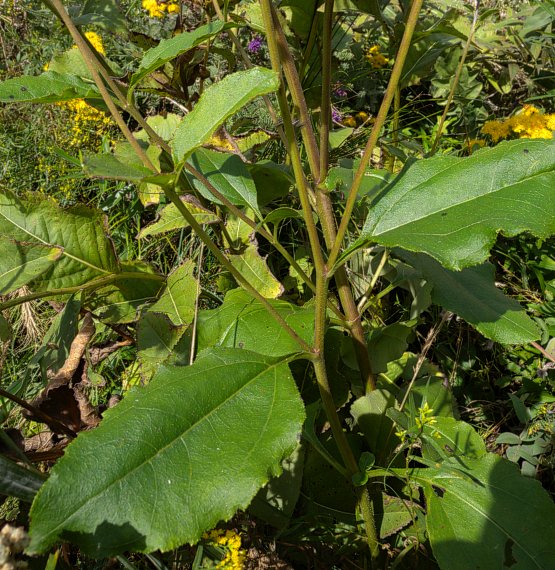
The upper stems terminate in either solitary flowerheads or small loose clusters of 2-3 flowerheads on long naked peduncles up to 1' long. These flowerheads tend to occur at different heights from the ground. The peduncles are similar to the stems, except they are a little more narrow in diameter. The flowerheads are held erect or at an angle facing partly upward; they span about 2-3" across. Each flowerhead has 10-20 ray florets and a central disk of numerous disk florets. The widely spreading petaloid rays are bright yellow and oblong in shape. The corollas of the disk florets are about 6 mm. (¼") long, tubular in shape with 5 upper lobes, and dark red above. The divided styles of the disk florets are bright yellow, while their tubular anthers are dark red. The ray florets are sterile, while the disk florets are perfect. Surrounding the base of each flowerhead, there are floral bracts (phyllaries) in 3 series; these bracts differ in size and they are appressed together. Individual floral bracts are light green and broadly oblong in shape; their tips are obtusely pointed or rounded. The margins of these bracts are toothless and ciliate; their outer surfaces between the margins are sparsely short-pubescent.

The blooming period occurs during early autumn, lasting about 3-4 weeks. Afterwards, fertile disk florets are replaced achenes about 4 mm. in length. These achenes are oblong-obovate, somewhat flattened, brown, and short-pubescent primarily toward their apices. Each achene has a pair of lanceolate scales about 2 mm. long at its apex. However, these scales are early-deciduous. Because the seeds are dispersed primarily by gravity, they usually do not travel far from the mother plant. The root system consists of a crown of fibrous roots and short rhizomes. Clonal offsets are produced sparingly from the short rhizomes.
Cultivation: This plant prefers full or partial sun and mesic to dry-mesic conditions; it adapts to different soil types, including those that contain sand, loam, clay, and rocky material. It is easy to cultivate this plant in gardens and it remains more or less erect, rather than flopping over. Because of its short rhizomes, it is a less aggressive spreader than some sunflower species.

Range & Habitat: Silphium Sunflower has been found in only 2 counties of southern Illinois (Alexander and St. Clair counties), where it is native and rare (see Distribution Map). It may be extirpated from Alexander county, but several populations of this plant still persist in St. Clair county. Illinois lies along the northern range-limit of this species. Silphium Sunflower is endemic to south-central and central United States, where it is found primarily in Arkansas, Missouri, and Tennessee. Habitats include sand prairies, upland prairies and glades, upland savannas, openings in rocky woodlands, low sandy ground along streams, roadsides, and fallow fields. This sunflower is found in both high quality natural areas and disturbed sites. In wooded habitats, it benefits from occasional wildfires. Destruction of habitat by development and invasion of exotic species are the primary threats to this rare plant in Illinois (Molano-Flores, 2004).

Faunal Association: While little is known about floral-faunal relationships for this particular sunflower species, considerable information is available about other sunflower species and sunflowers in general. Similar species of sunflowers attract such flower-visiting insects as bumblebees, long-horned bees (Melissodes spp.), leaf-cutter bees (Megachile spp.), Halictid bees (Agapostemon spp., Lasioglossum spp.), Andrenid bees (Andrena spp.), dagger bees (Heterosarus spp.), plasterer bees (Colletes spp.), cuckoo bees (Epeolus spp., Triepeolus spp.), miscellaneous wasps, Syrphid flies (Eristalis spp., Toxomerus spp.), bee flies (Exoprosopa spp.), miscellaneous butterflies, and miscellaneous skippers (Robertson, 1929, and others). Some bees are specialist pollinators (oligoleges) of sunflowers; they include Melissodes agilis, Dufourea marginata, Andrena accepta, Andrena aliciae, Andrena helianthi, and Pseudopanurgus rugosus. Other insects feed destructively on the leaves, stems, roots, seeds, and florets of sunflowers. These species include weevils, long-horned beetles, leaf beetles, billbugs, seed weevils, larvae of leaf-miner flies, larvae of gall midges, plant bugs, aphids, treehoppers, mealybugs, larvae of Tortricid moths, larvae of Noctuid moths, larvae of other moths, grasshoppers, and flower thrips. The caterpillars of some butterflies feed on sunflowers; these species include Chlosyne gorgone (Gorgon Checkerspot), Chlosyne nycteis (Silvery Checkerspot), and Vanessa cardui (Painted Lady); see Bouseman & Sternburg, 2001; Charlet & Gavloski, 2011. Some vertebrate animals use sunflowers as a source of food. Upland gamebirds and songbirds eat their nutritious seeds; the Mourning Dove, Bobwhite Quail, American Crow, Eastern Goldfinch, Common Grackle, Eastern Meadowlark, White-breasted Nuthatch, and various sparrows are examples of such birds (Lewis, 1993; Martin et al., 1951/1961). White-tailed Deer and domesticated grazing animals like to feed on the young stems and leaves of these plants (Georgia, 1913; Martin et al., 1951/1961). The seeds of sunflowers are dispersed to a limited extent by birds; sometimes they drop the seeds during flight before they consume them.

Photographic Location: The wildflower garden of the webmaster in Urbana, Illinois.
Comments: The Silphium Sunflower (Helianthus silphioides) is often overlooked in wildflower guidebooks and it is little-known by members of the public. This is partly because, for a long time, this sunflower was considered a variety of the Purple-disk Sunflower (Helianthus atrorubens). However, the Silphium Sunflower differs from the latter by having fewer long hairs on its stems, more narrow and less winged petioles, and achenes that are pubescent primarily toward their apices, rather than throughout. The Purple-disk Sunflower is found primarily in SE United States; it does not occur in Illinois. Scientific synonyms of the Silphium Sunflower include Helianthus atrorubens pubescens and Helianthus kentuckiensis. Other common names of this sunflower include Rosinweed Sunflower and Ozark Sunflower. The common names, Silphium Sunflower and Rosinweed Sunflower, refer to the superficial similarity of this sunflower to the prairie wildflower, Silphium integrifolium (Rosinweed). It also resembles Heliopsis helianthoides (False Sunflower) to a significant extent, but the flowerheads of Silphium Sunflower are borne on longer naked stalks than those of the False Sunflower, and it usually blooms later in the year than the latter species.